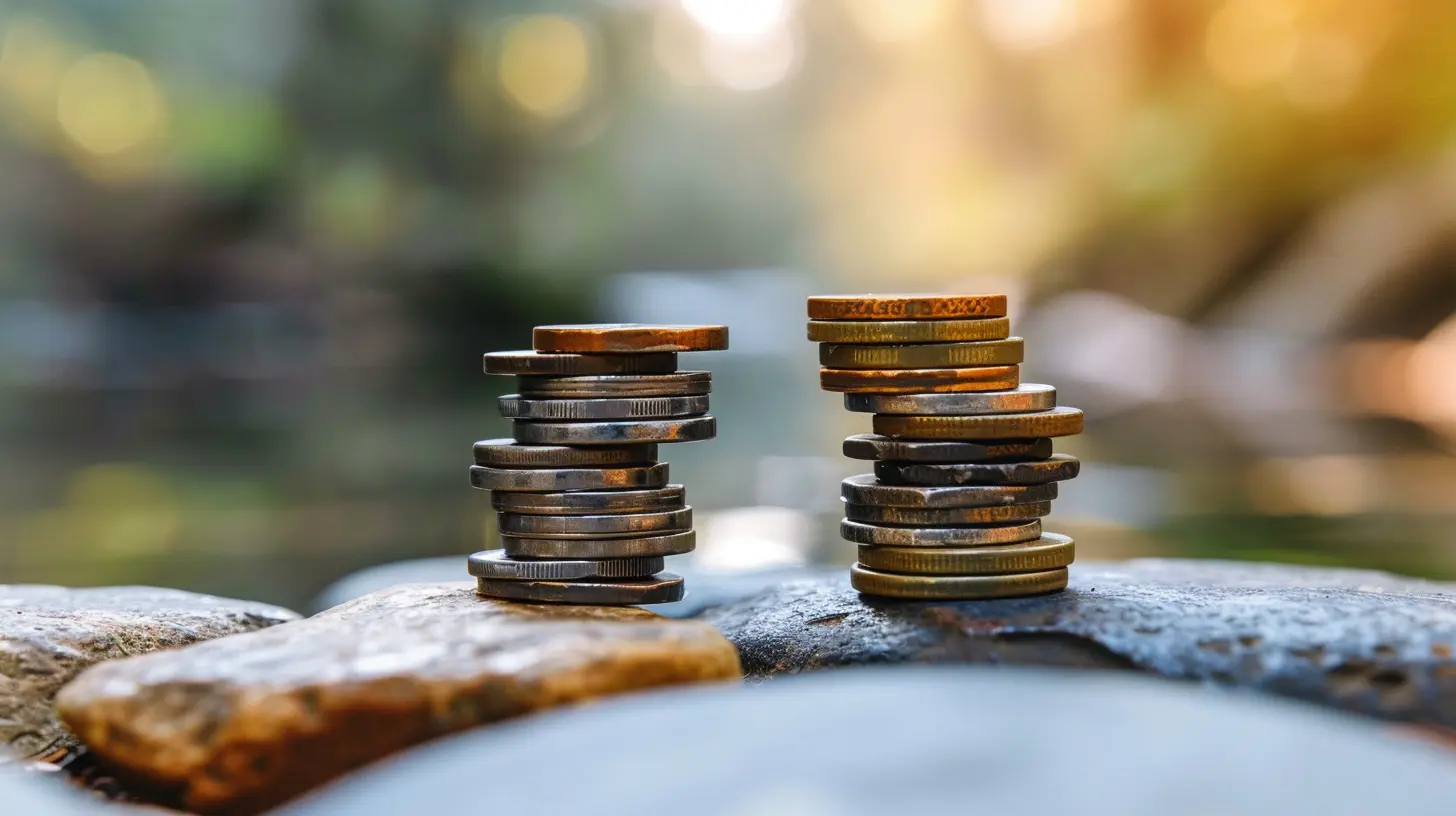Balancing Short-Term and Long-Term Investments for Optimal Diversification
29 March 2025
Investing is a game of strategy. If you put all your money into one type of investment, you're taking a big risk. One market crash could wipe out your savings. On the other hand, if you spread your investments wisely, you can enjoy growth while minimizing risks. That’s where balancing short-term and long-term investments comes in.
The key? A well-diversified portfolio that aligns with your financial goals, risk tolerance, and timeline. Let’s break it down and see how you can strike the right balance. 
Understanding Short-Term and Long-Term Investments
Before we start mixing and matching, it’s important to understand what each type of investment brings to the table.Short-Term Investments
Short-term investments are assets that can be converted into cash relatively quickly—typically within a few months to five years. These are great for liquidity, quick returns, and less volatility.Examples of short-term investments:
- Savings accounts – Safe, but low returns.
- Certificates of Deposit (CDs) – Moderate returns, requires locking in money for a set time.
- Money market accounts – Low-risk, easy access to funds.
- Treasury bills (T-bills) – Backed by the government, low-risk but limited gains.
- Stocks for short-term trading (Day trading, Swing trading) – Potential for high rewards, but also higher risks.
Long-Term Investments
Long-term investments aim for sustained growth over several years, often spanning decades. These provide compound interest benefits and higher returns but require patience.Examples of long-term investments:
- Stocks (for long-term growth) – Investing in solid companies that grow over time.
- Bonds – Steady, fixed-income investments.
- Real estate – Property investments for rental income and appreciation.
- Mutual funds & ETFs – Diversified investments reducing risk exposure.
- Retirement accounts (401(k), IRA) – Designed for wealth accumulation over decades. 
Why Balancing Short-Term and Long-Term Investments Matters
Investing all your money in short-term assets means you may never experience significant growth. On the flip side, putting everything into long-term assets means you may struggle with cash flow when you need it the most. Striking a balance is the secret sauce.1. Liquidity vs. Growth
Short-term investments ensure that you have cash available when needed, whether it’s for emergencies, buying a home, or unexpected expenses. Long-term investments, however, help in wealth accumulation by riding out market fluctuations.Think of it like filling your pantry. Some items (like fresh fruits and vegetables) need to be used quickly, while others (like canned goods and dry pasta) can be stored for years. A good portfolio works the same way—you need a mix of short-term accessibility and long-term security.
2. Managing Risk
Markets are unpredictable. Stocks rise and fall, real estate values fluctuate, and inflation eats into your savings. Diversifying between short-term and long-term investments minimizes the impact of volatility.For example, if a stock market crash hits, your short-term investments (like bonds and money market accounts) can provide stability. Conversely, if inflation rises, your long-term investments (like real estate and stocks) outpace its effects.
3. Maximizing Compounding Benefits
Compounding works best when you give it time. Long-term investments, such as stocks and retirement accounts, let small amounts grow exponentially over the years.A $10,000 investment in the stock market today, earning an average of 8% per year, could grow to over $100,000 in 30 years. That’s the power of letting your money work for you.
Short-term investments won’t reap the same compounding benefits, but they serve a different purpose—providing liquidity and safety. 
How to Find the Right Balance
There’s no one-size-fits-all approach to balancing short-term and long-term investments. The right mix depends on your financial goals, risk appetite, and stage in life.1. Assess Your Financial Goals
- Do you need money in the next few years for a down payment on a house? Prioritize short-term investments.- Are you saving for retirement decades away? Focus on long-term investments.
- Want a mix of both? Allocate accordingly based on timeframes.
2. Consider Your Risk Tolerance
Some people are comfortable taking risks, while others prefer playing it safe. If you’re risk-averse, you might lean toward bonds and fixed deposits. If you’re comfortable with volatility, stocks and mutual funds could be great long-term options.3. Follow the Rule of 70-30 (or 60-40)
A common strategy is the 70-30 rule, where 70% of your portfolio goes into long-term investments and 30% into short-term investments. If you're closer to retirement, you might adjust this to 60-40 or even 50-50.4. Rebalance Your Portfolio Periodically
Life changes, and so should your investment strategy. Review your portfolio every 6-12 months to ensure it aligns with your goals. If short-term investments make up too much of your portfolio (or vice versa), adjust accordingly.
Common Mistakes to Avoid
1. Ignoring Short-Term Needs
Many investors get so caught up in building long-term wealth that they forget about liquidity. Always keep some assets easily accessible.2. Being Too Conservative
While safety is important, keeping too much in low-yield short-term investments means losing out on long-term growth. Inflation can eat away your purchasing power.3. Chasing Quick Gains
Trying to time the market or making impulsive trades can result in losses. A long-term mindset often leads to more stable returns.4. Lack of Diversification
Don’t put all your money into one type of investment. A balanced portfolio spreads risk and enhances returns.The Bottom Line
Balancing short-term and long-term investments isn’t about choosing one over the other—it’s about finding the sweet spot. A strong financial plan includes both, ensuring you have funds when you need them while still growing wealth over time.Take the time to assess your needs, create an investment plan, and stay disciplined. Investing isn’t about getting rich overnight, but about making smart, calculated decisions that set you up for long-term success.
all images in this post were generated using AI tools
Category:
Portfolio DiversificationAuthor:

Harlan Wallace
Discussion
rate this article
12 comments
Zayne Lane
This article provides valuable insights into the importance of balancing short-term and long-term investments. A well-rounded approach to diversification can truly enhance financial stability and growth opportunities. Great read!
April 8, 2025 at 11:29 AM

Harlan Wallace
Thank you for your kind words! I'm glad you found the insights on balancing investments and diversification valuable.
Solenne McRae
Great article! Striking the right balance between short-term gains and long-term growth is key to a successful investment strategy. Here’s to smart choices and a flourishing financial future! 🍀✨
April 7, 2025 at 12:01 PM

Harlan Wallace
Thank you! I appreciate your insights on balancing short-term and long-term investments for a successful strategy. Here’s to informed decisions and lasting success! 🍀✨
Julian Ortiz
Achieving financial success means mastering the art of balance—embrace both short-term gains and long-term growth for true prosperity!
April 6, 2025 at 1:00 PM

Harlan Wallace
Absolutely! Balancing short-term gains with long-term growth is key to achieving optimal diversification and sustained financial success.
Vireo Dillon
This article effectively highlights the importance of balancing short-term and long-term investments for optimal diversification. By understanding the unique benefits and risks associated with each strategy, investors can achieve a well-rounded portfolio that adapts to market fluctuations while aligning with their financial goals. Great insights!
April 6, 2025 at 3:44 AM

Harlan Wallace
Thank you for your thoughtful feedback! I'm glad you found the insights on balancing investments helpful for achieving a well-rounded portfolio.
Anastasia Sullivan
Great insights! Striking the right balance between short-term gains and long-term growth is key to any investment strategy. It’s all about knowing your goals and risk tolerance. Thanks for sharing these valuable tips on achieving optimal diversification—I can't wait to apply them to my portfolio!
April 5, 2025 at 12:48 PM

Harlan Wallace
Thank you! I'm glad you found the tips helpful. Best of luck with your portfolio!
Knox Moore
How can we effectively measure investment balance strategies?
April 4, 2025 at 8:03 PM

Harlan Wallace
To effectively measure investment balance strategies, consider using metrics like risk-adjusted returns, volatility assessments, and diversification ratios. Regularly review performance relative to your investment goals and adjust your strategy accordingly.
Ethan Burton
This article effectively highlights the importance of balancing short-term and long-term investments. A well-structured approach can enhance diversification and ultimately lead to better financial stability.
April 4, 2025 at 11:39 AM

Harlan Wallace
Thank you for your feedback! I'm glad you found the article's insights on balancing investments helpful for achieving diversification and financial stability.
Andrea Kelly
Great insights! Finding the right balance between short-term gains and long-term stability can feel like a juggling act. It's all about understanding your goals and risk tolerance. I appreciate the tips on diversification; they really make the investment journey feel less daunting and more achievable!
April 3, 2025 at 2:53 AM

Harlan Wallace
Thank you! I'm glad you found the tips helpful. Balancing short-term and long-term goals is key to successful investing!
Kate Dorsey
Striking a balance between short-term gains and long-term growth enhances portfolio resilience, minimizing risk while maximizing potential returns over time.
April 2, 2025 at 3:23 AM

Harlan Wallace
Thank you! I completely agree—finding that balance is crucial for achieving sustainable investment success.
Brick McCool
Great insights! Balancing short-term and long-term can truly enhance investment strategy effectiveness.
March 31, 2025 at 7:03 PM

Harlan Wallace
Thank you! I'm glad you found the insights valuable. Balancing both approaches is indeed key to a robust investment strategy.
Isla Lambert
Striking a balance between short-term gains and long-term growth is essential for a well-rounded investment strategy that withstands market fluctuations.
March 31, 2025 at 12:09 PM

Harlan Wallace
Absolutely! Balancing short-term and long-term investments is key to creating a resilient portfolio that can adapt to market changes while maximizing potential returns.
Valeria McPhee
Great insights! Finding the right balance between short-term gains and long-term stability can be tricky. This article really highlights the importance of diversification in achieving financial goals. Thanks for sharing these valuable tips!
March 30, 2025 at 4:30 AM

Harlan Wallace
Thank you for your kind words! I'm glad you found the article helpful in navigating the balance between short-term gains and long-term stability. Happy investing!
MORE POSTS

The Role of ETFs in a Balanced Stock Portfolio

The Intersection of Speculation and Technology in Financial Markets

Diversifying Your Portfolio with Private Equity Investments

Strategies for Donating Highly Appreciated Assets to Reduce Capital Gains

Alternative Strategies for Accelerating Your Retirement Savings

The Role of Minimalism in Achieving Financial Freedom

How to Track Your Tax Refund: Tools and Tips

Navigating the Regulatory Risks in Speculative Investments